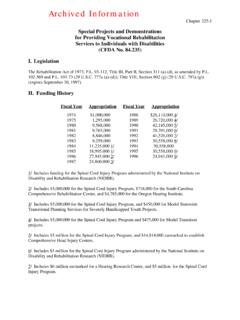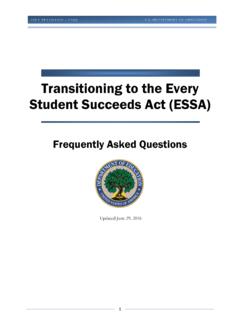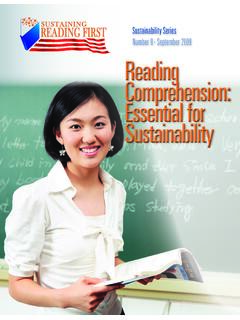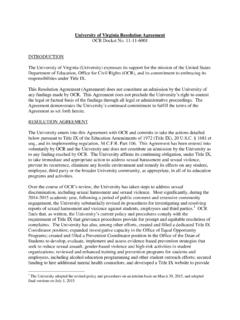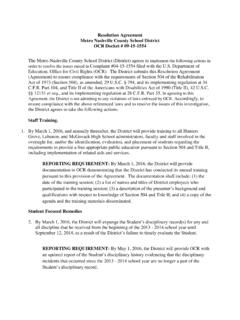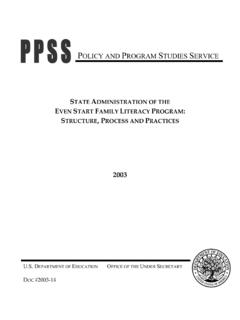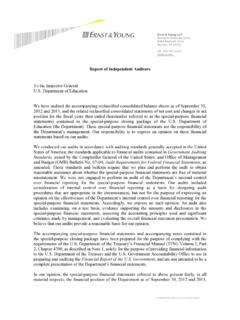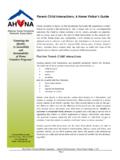Transcription of Chapter 6 Tools and Resources for Addressing English ...
1 Updated November 2016 ESSA UPDATE INCLUDED*1 Tools AND Resources FOR Addressing English LEARNERS WITH DISABILITIESCHAPTER 6 Tools AND Resources FOR Addressing English LEARNERS WITH DISABILITIESThis is the sixth Chapter of the English Learner tool Kit, which is intended to help state and local education agencies (SEAs and LEAs) meet their obligations to English Learners (ELs). This tool kit should be read in conjunction with the Department of Education Office for Civil Rights (OCR) and the Department of Justice s (DOJ) Dear Colleague Letter on English Learner Students and Limited English Proficient parents , published in January 2015, which outlines SEAs and LEAs legal obligations to ELs under civil rights laws and other federal requirements.
2 The Dear Colleague Letter can be found at AND Resources FOR Addressing English LEARNERS WITH DISABILITIESKEY POINTS LEAs must identify, locate, and evaluate ELs with disabilities in a timely manner. LEAs must consider the English language proficiency of ELs with disabilities in determining appropriate assessments and other evaluation materials. LEAs must provide and administer special education evaluations in the child s native language, unless it is clearly not feasible to do so, to ensure that a student s language needs can be distinguished from a student s disability-related needs.
3 LEAs must not identify or determine that EL students are students with disabilities because of their limited English language proficiency. LEAs must provide EL students with disabilities with both the language assistance and disability-related services they are entitled to under federal Individuals with Disabilities Education Act (IDEA) and Section 504 of the Rehabilitation Act of 1973 (Section 504) address the rights of students with disabilities in school and other educational settings. If an EL is suspected of having one or more disabilities, the LEA must evaluate the EL promptly to determine if the EL has a disability or disabilities and whether the EL needs disability-related services (which are special education and related services under IDEA or regular or special education and related aids and services under Section 504).
4 Disability evaluations may not be delayed because of a student s limited English language proficiency (ELP) or the student s NOTE: Neither this tool kit nor the above-cited OCR/DOJ Dear Colleague Letter is intended to be a replacement for the careful study of Part B of the Individuals with Disabilities Act (IDEA) and Section 504 of the Rehabilitation Act of 1973 (Section 504), which govern the education of students with disabilities. More information about IDEA and Section 504 can be found at: and #Section504, respectively.*This Chapter has been updated to reflect changes in the Elementary and Secondary Education Act (ESEA), as amended by the Every Student Succeeds Act of 2015 (ESSA).
5 The Department of Education has released a non-regulatory guidance (NRG) about ESSA and ELs that is available at The text of the ESEA, as amended by ESSA, can be found at November 2016 You can access Tools and Resources for Addressing English Learners with Disabilities at can access Tools and Resources for Addressing English Learners with Disabilities at AND Resources FOR Addressing English LEARNERS WITH DISABILITIESU pdated November 2016participation in a language instruction educational program (LIEP). Also, a student s ELP cannot be the basis for determining that a student1 has a disability.
6 It is important for educators to accurately determine whether ELs are eligible for disability-related services. Research shows that there is variability in how LEAs identify ELs as eligible for special education services; some LEAs over-identify and others under-identify ELs as eligible for special education services when compared to non-ELs (Artiles, Rueda, Salazar, & Higareda, 2005; Zehler et al., 2003). Researchers have identified four potential factors that may contribute to the misidentification of special education needs, and learning disabilities in particular, among students who are ELs: (1) the evaluating professional s lack of knowledge of second language development and disabilities; (2) poor instructional practices; (3) weak intervention strategies; and (4) inappropriate assessment Tools (S nchez, Parker, Akbayin, & McTigue, 2010).
7 Appropriate disability identification processes that evaluate the student s disability-related educational needs and not the student s English language skills will help school personnel to accurately identify students in need of disability-related services. In addition, LEAs must ensure that a student s special education evaluation is provided and administered in the student s native language or other mode of communication and in the form most likely to yield accurate information about what the student knows and can do, unless it is clearly not feasible to do so.
8 Assessing whether a student has a disability in his or her native language or other mode of communication can help educators ascertain whether a need stems from lack of ELP and/or a student s disability-related educational IDEA and Section 504 require that schools provide a free appropriate public education (FAPE) to eligible or qualified students with disabilities. Under IDEA, FAPE requires, among other things, the provision of special education and related services at no cost to the parents in conformity with an individualized education program (IEP).
9 An IEP is a written document, developed at a meeting of the IEP team, that describes specialized instruction and related services to address the student s needs that result from the student s disability. LEAs must develop and implement either an IEP under IDEA, or convene a group of knowledgeable persons to 1 IDEA refers to a child with a disability. In this document student is used to mean child under IDEA. determine what services the student should receive under Section 504, as appropriate. Depending on the individual needs of the student, FAPE under Section 504 could include regular or special education and related aids and services designed to meet the individual educational needs of students with disabilities as adequately as the needs of nondisabled students are met.
10 While Section 504 and IDEA are different statutes, as reflected in ED s regulations, one way to meet the requirements of Section 504 FAPE is to implement an IEP developed in accordance with IDEA. When an EL student is determined to be a child with a disability as defined in IDEA, or an individual with a disability under the broader definition of disability in Section 504 the student s EL and disability-related educational needs must be met. For EL students, in addition to the required IEP team participants under IDEA, it is essential that the IEP team include participants who have knowledge of the student s language needs.

